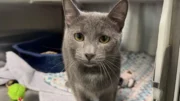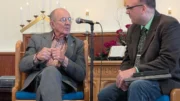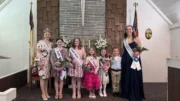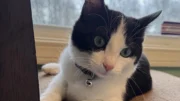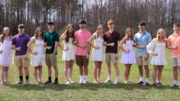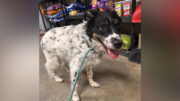There is a great book called “The Great Picture Hunt” by Dave LaBelle, a terrific feature photographer. I saw a copy years ago and finally went looking for it about the time he was putting out his second edition, which I then bought. To me, it was a text book loaded with fun writing about the approach to your subjects and how to find candid moments. His photographs are quite good, which gives the book even more street cred among photographers!
I loved it.
But, I did find out, working in a small town where many people are used to seeing me around, that it does become difficult to get that truly candid moment when out and about, not at an event with lots going on.
So, today began with my driving by these apparent twins with spectacular hair walking across a bridge. I found the nearest parking spot I could and made a couple photos with a long lens of them walking towards me. Problem is – they caught me right way. Those kids have really good eyes!
And so did their dad.
I am aware of the “creep with a camera,” so at this point I just abandoned the idea of a true slice of life candid and just met the family about halfway across the bridge to introduce myself and my intention. I give my name and who I work for and why I was taking their picture. Most of the time this leads me into a longer conversation and the focus of my picture then changes. I make some snaps of them looking at the camera smiling and just getting comfortable with me. And we talk. (If they say no pictures, I understand and I leave them alone, but make sure they know who I am so they don’t think there is someone in the community to be concerned with. I often give them my card.)
They were in fact twins and they were visiting their dad. The dad was very attentive and sweet to his girls, helping them with their head bands and telling them when he saw spider webs on the bridge’s railing. They were out for an afternoon walk to get lunch at the nearby McDonald’s. Up close, I was back to my comfort zone using my wide angle lens.
I prefer wide angle and close, mostly because I can hear what is going on. My ears are as much apart of my photographic storytelling as my eyes. I also prefer it because I am very near-sighted and when I’m close I can actually put the camera down away from my face and really look at things more easily With the wide angle, I know I’m still photographing what I see (unless I get too dramatic with angling the camera when I’m too close.)
After leaving this family, who I enjoyed meeting, I got back in my car and began looking some more on my way in to work.
I saw a mother and daughter in the city’s park on blankets reading.
It’s not a big park and I felt if I just began snapping photos I potentially could frighten or weird them out. So I didn’t try. I approached them and introduced myself. They were getting ready to leave to get something to drink and return. They offered to stay so I could get my photo. I said no, that’s okay, I was really looking for people enjoying the day and I just wanted them to know what I was doing in the park but didn’t want them to pretend. I said I’ll be here for awhile and I’ll probably keep an eye out for them when they get back.
Not far away, I saw a family having lunch at a picnic table. At this point, I still felt it best to approach first and let them know what I was doing in the park, so I did.
Now, in doing this you really take away that idea of getting a true look into real life. As soon as your subject knows you are there, they become at least conscious of you, even if they try to ignore you. I walked away and decided to observe with a long lens. A short time later, the young boy lifted his sandwich toward the man and the man took a bite. I thought this was a sweet moment and real. They might have known I was there, but they still shared a nice moment.
I was also aware that the man was on lunch break from work and his family drove about 20 minutes just to meet him for lunch, so I didn’t want to ruin their fun together. So I didn’t stick around and bother them for very long.
A city employee was mowing grass, so I figured I’d try to work getting this activity documented while trying to show the spring flowering trees. I didn’t quite wrap my brain around this image, though I tried several frames before I abandoned the idea. At this point the mother and daughter were back on their blanket reading.
I tried to be undetected and might have gotten a frame or two off but it didn’t take long to be found out. (Another thing, can Canon make their shutter and mirror assembly any louder? Mirrorless technology I am watching!!! By the way, Nikon is loud, but this D1X is the loudest camera I’ve ever heard.) I liked the photo I was able to get. I wanted to get layers that showed the park and possibly other life going on while these two were in a world all their own. But I didn’t like that waste bucket and the proximity to the mom’s head.
Since I was discovered again, I moved in closer and I told them I wanted to hear the story. I laid on the grass in front of them, focused and just hung out waiting for whatever it is we wait for when we want to get an authentic moment. I got the frame at the very top of this post with the little girl showing her mom that she knows what the ‘kooky signal’ was and thought that was probably my best picture. But then they seemed to forget I was there.
And though it might not have that immediate impact of a moment, it really felt the most genuine, as if I weren’t even there.
And that is the goal.
Tonight, I am digging out LaBelle’s book again and studying!






















